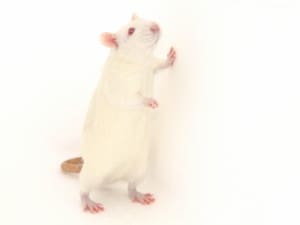Sprague Dawley
Sprague Dawley
| Strain details | |
|---|---|
| Nomenclature | OzarcCrl:CD(SD)IGS |
| Common name | Sprague Dawley |
| Synonyms | CD(SD), CD (Sprague Dawley), SD |
| Strain | Outbred |
| Coat colour | Albino |
| Species | Rat |
| Genetic background | - |
| Location | Vivarium 4 |
| Supply | Tier 1: off-the-shelf, pre-allocation, breed on request |
Strain description
- Animals are docile.
- Females are good foster mothers.
- Mammary tumours are common in older females.
- Popular rat to function as foster parents in caesarean procedures.
- Intelligent rat, thus popular model for psychology tests.
- Tendency to become very fat with age.
- Barbering when older than 8 weeks of age.
- Originated in 1925 by Robert W. Dawley from a hybrid hooded male and a female Wistar rat. To Charles River in 1950 from Sprague Dawley, Inc.
- Charles River Breeding Laboratories obtained the stock after CRL had re- established an International Genetic Standard colony.
- Received as CD stock from Charles River Breeding Laboratories, (April 1999) as SPF stock. Passed directly into the SPF barrier after quarantine in flexible film isolator to verify SPF status.
- Stock strain is transferred to Ozgene ARC from Animal Resource Centre (ARC), Western Australia in 2023.
- Animal is a multipurpose model that can be used in fields such as toxicology (safety and efficacy testing), aging and oncology.
| Sprague Dawley (OzarcCrl:CD(SD) IGS) | ||
|---|---|---|
| WKS | MALE | FEMALE |
| 3 | 33 - 74 | 31 - 79 |
| 4 | 55 - 111 | 63 - 127 |
| 5 | 92 - 180 | 113 - 164 |
| 6 | 134 - 236 | 118 - 197 |
| 7 | 166 - 259 | 135 - 229 |
| 8 | 256 - 343 | 149 - 254 |
| 9 | 262 - 363 | 165 - 281 |
| 10 | 313 - 453 | 176 - 298 |
| 11 | 347 - 497 | 182 - 338 |
| 12 | 387 - 518 | 192 - 322 |
| 13 | 371 - 558 | 261 - 331 |
| 14 | 376 - 586 | 232 - 367 |
- Animals are not allowed to be used for propagation.
- Ozgene ARC terms and Conditions
- Rat images are representative only. Actual phenotypes may vary based on genotype, sex, age, husbandry, health status, and other factors.


